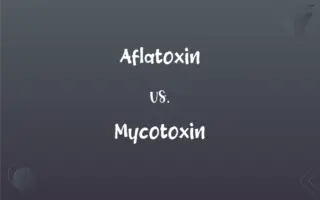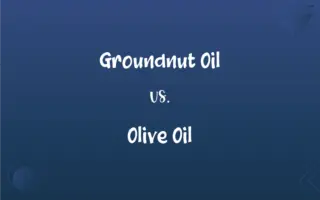Shotgun Sequencing vs. Next Generation Sequencing: What's the Difference?
Edited by Janet White || By Harlon Moss || Published on February 25, 2024
Shotgun sequencing is a method that randomly fragments DNA for sequencing, while next generation sequencing (NGS) refers to modern, high-throughput DNA sequencing technologies.

Key Differences
Shotgun Sequencing involves breaking down DNA into random, small fragments and then sequencing these fragments. This method is used to reconstruct the original DNA sequence. Next Generation Sequencing (NGS), on the other hand, represents a suite of advanced techniques that allow for massively parallel sequencing of numerous DNA fragments, significantly increasing speed and efficiency.
Shotgun Sequencing was revolutionary in its time for enabling the sequencing of complex genomes, such as the human genome. It requires extensive computational resources to assemble the sequenced fragments. NGS technologies have built upon and vastly improved the efficiency of this process, making it faster, cheaper, and more accurate.
A key aspect of Shotgun Sequencing is its ability to sequence long, complex DNA strands by breaking them into manageable pieces. However, it can be labor-intensive and time-consuming. NGS methods, while also utilizing fragmenting of DNA, are automated and can handle millions of fragments simultaneously, dramatically cutting down the time and labor involved.
Shotgun Sequencing often requires cloning of fragments into bacterial vectors for amplification before sequencing. This step is not needed in Next Generation Sequencing, as NGS can amplify DNA fragments directly on a sequencing platform, further reducing the time and complexity of the process.
Shotgun Sequencing was a groundbreaking method for its time, while Next Generation Sequencing represents a significant advancement in sequencing technology, offering higher throughput, greater accuracy, and reduced costs.
ADVERTISEMENT
Comparison Chart
Method
Random fragmentation of DNA
High-throughput, parallel sequencing
Speed
Slower, labor-intensive
Rapid and efficient
Scale
Suitable for large genomes, but time-consuming
Handles large-scale projects easily
Technology
Older, foundational technology
Modern, advanced technology
Application
Pioneered genome sequencing
Used in research, clinical diagnostics, and more
ADVERTISEMENT
Shotgun Sequencing and Next Generation Sequencing Definitions
Shotgun Sequencing
Involves sequencing small DNA fragments and assembling them.
Shotgun sequencing was used to piece together the DNA of extinct species.
Next Generation Sequencing
Eliminates the need for fragment cloning in sequencing.
NGS streamlined the process of genome sequencing in labs worldwide.
Shotgun Sequencing
Pioneered large-scale genome sequencing projects.
Shotgun sequencing enabled the first complete bacterial genome sequencing.
Next Generation Sequencing
Allows simultaneous sequencing of millions of DNA fragments.
NGS enabled rapid sequencing of the COVID-19 genome.
Shotgun Sequencing
Less efficient compared to modern sequencing techniques.
While effective, shotgun sequencing has been largely superseded by NGS methods.
Next Generation Sequencing
Used widely in research, diagnostics, and personalized medicine.
Next generation sequencing is critical in identifying genetic disorders.
Shotgun Sequencing
A method of sequencing DNA by breaking it into random fragments.
The human genome project utilized shotgun sequencing to map human DNA.
Next Generation Sequencing
Provides faster, more accurate, and cost-effective sequencing.
NGS has made personalized medicine more feasible and affordable.
Shotgun Sequencing
Requires computational assembly of sequenced fragments.
Advanced algorithms were developed to assemble shotgun sequencing data.
Next Generation Sequencing
A modern, high-throughput method for DNA sequencing.
Next generation sequencing revolutionized cancer genomics research.
FAQs
What is shotgun sequencing?
A method of sequencing DNA by randomly breaking it into smaller fragments and then assembling them.
What defines next generation sequencing?
Next generation sequencing is a modern, efficient method that sequences millions of DNA fragments simultaneously.
Is shotgun sequencing still used?
Yes, but it has been largely superseded by next generation sequencing due to the latter's efficiency.
How does shotgun sequencing work?
It involves breaking DNA into random pieces, sequencing these pieces, and then computationally assembling them back together.
Does shotgun sequencing require cloning of DNA fragments?
Traditionally, yes, it required cloning into vectors before sequencing.
Can next generation sequencing handle large genomes?
Yes, NGS is well-suited for large-scale sequencing projects, including complex genomes.
What was the major contribution of shotgun sequencing?
It was crucial in pioneering the sequencing of large genomes, such as the human genome.
How has next generation sequencing impacted research?
NGS has revolutionized genetic research, allowing for rapid and comprehensive studies.
How accurate is next generation sequencing?
NGS offers high accuracy, with advanced error-correction techniques.
What are the main advantages of next generation sequencing?
It offers high-throughput, accuracy, speed, and cost-effectiveness.
What is the accuracy like in shotgun sequencing?
It is accurate but can be prone to errors, especially in repetitive regions.
Does next generation sequencing need cloning?
No, NGS sequences DNA directly on a platform, eliminating the need for cloning.
What are the limitations of shotgun sequencing?
It's time-consuming, labor-intensive, and less suitable for very large-scale projects.
Has next generation sequencing improved genetic diagnosis?
Yes, NGS has greatly enhanced the speed and accuracy of genetic diagnosis.
What's the turnaround time for next generation sequencing?
NGS can produce results in a matter of days, depending on the project.
Was shotgun sequencing used in the Human Genome Project?
Yes, it was a key technique in sequencing the human genome.
Can next generation sequencing be used for personalized medicine?
Absolutely, NGS is pivotal in developing personalized medicine approaches.
In what fields is next generation sequencing used?
It's used in various fields, including medicine, genetics, microbiology, and evolutionary biology.
Are there any limitations to next generation sequencing?
While highly efficient, NGS can be expensive and requires specialized equipment and expertise.
How long does shotgun sequencing take?
It can take weeks to months, depending on the project's scale.
About Author
Written by
Harlon MossHarlon is a seasoned quality moderator and accomplished content writer for Difference Wiki. An alumnus of the prestigious University of California, he earned his degree in Computer Science. Leveraging his academic background, Harlon brings a meticulous and informed perspective to his work, ensuring content accuracy and excellence.
Edited by
Janet WhiteJanet White has been an esteemed writer and blogger for Difference Wiki. Holding a Master's degree in Science and Medical Journalism from the prestigious Boston University, she has consistently demonstrated her expertise and passion for her field. When she's not immersed in her work, Janet relishes her time exercising, delving into a good book, and cherishing moments with friends and family.






































































